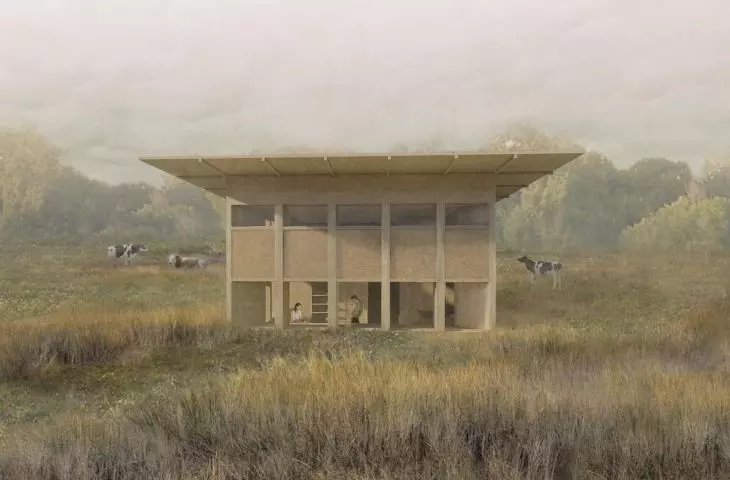Architecture students of the Warsaw University of Technology: Alicja Adela Jarochowska and Aleksandra Musial won as many as two awards in the international MICROHOME #5 competition organized by Buildner. Their project „Grounded House”, a biomass—heated house made of rammed earth, wood and potato cork, received the third prize and the Buildner Student Award!
MICROHOME #5 is the fifth edition of the competition announced periodically by the Buildner platform, organized in cooperation with Archive Books, as part of the „Architecture of Small Scale” series. The contest aims to highlight the importance that small—scale architecture can have in the face of the housing, economic and climate crisis. The organizers are looking for model solutions—designs for a small house of twenty—five square meters for two people. While the location, materials and functions were arbitrary. Preference was given to modern solutions in the spirit of sustainability and those that focus on a selected social problem.
The house was made of modular wooden boxes filled with earth
© Alicja Adela Jarochowska, Aleksandra Musial
double success of polish students
The works submitted for the international competition were judged by a jury consisting of Thomas Christoffersen (BIG—Bjarke Ingels Group), Sevince Bayrak (SO?), Sarah Broadstock (Studio Bark), Anne Cecilie Haug (Snøhetta), Gavin Hale—Brown (Henley Hale—Brown), Norihisa Kawashima (Nori Architects), Francesca Perani (Francesca Perani Enterprise), Patrik Schumacher (Zaha Hadid Architects). First Prize went to the Micro Colony project by a team from the Netherlands consisting of: Misak Terzibasiyan, Amir Feizinezhadgheshlagh and Thimo Derks.
Second Prize went to Lionel Giordano of the United Kingdom for his Degradable dwelling project.
Grounded House was designed for rural areas
© Alicja Adela Jarochowska, Aleksandra Musial
TheThird Prize and the Buildner Student Award were given by the jury to Aleksandra Musial and Alicja Adela Jarochowska from the Warsaw University of Technology for the Grounded House project.
As the justification reads, the award was given for being contemporary and integrated with the environment:
Thoughtful modular tiny house in the landscape. The use of daylight and views with built—in furniture between columns creates both a connection to the environment and a sense of privacy—well put together and illustrated—Thomas Christoffersen (BIG).
Very skillful use of modular construction and local resources. The design is well planned and well presented, only a small number of submissions have managed to realize the concept with so little compromise—Gavin Hale-Brown (Henley Hale-Brown).
Grounded House is dug into the ground
© Alicja Adela Jarochowska, Aleksandra Musial
Grounded House
The small square house is constructed of earth, wood and potato cork. The slightly sloping flat roof gives the form of the building a certain visual lightness, balancing the heavy body. The roof extends beyond the outline of the walls, protecting the structure from the changing weather.
Our Grounded House project, or Grounded House—of the earth, about the earth and for the earth, is a house designed for rural areas in temperate terrain. We focused on this location not only because it is close to us, but also to take on the challenge of an unpopular climate zone in the competition—most participants design in warm climates, thus bypassing the topic of energy and building insulation. Our additional mission is to „disenchant” materials, which are commonly associated negatively—cheap, dirty, inelegant, ugly. We wanted to show that rammed earth, bio—waste energy or dried potato insulation have nothing to do with these terms. Instead, they can be used in the most modern and aesthetically pleasing way possible, and provide an alternative to other, more popular materials, winning over them with their locality, efficiency and simplicity.—explain the winners of the competition.
Grounded House is full of natural light
© Alicja Adela Jarochowska, Aleksandra Musial
insulation made of potato peelings
The competition building is dug into the ground to a height of about one meter. As the authors explain, this is, on the one hand, a symbolic gesture to bring people closer to nature (by literally lowering the horizon line), and on the other hand, a way to increase the thermal mass of the building.
The structure of the house is made up of wooden boxes filled with earth
© Alicja Adela Jarochowska, Aleksandra Musial
The excavated earth served the students as insulation in the modular boxes that make up the structure. In addition, the authors decided to use an unusual but simple material—cork from potato peels. The cork was used for thermal insulation and applied to the building's facade.
The heating and all appliances in the house are powered by biomass
© Alicja Adela Jarochowska, Aleksandra Musiał
Heating and all appliances in the house are powered by biomass, the tank of which is hidden under the terrace of the building. This solution allows energy production regardless of the weather. Householders can use leftover food, fertilizer and other organic waste, thereby reducing the problem of food waste in agrarian areas.
Read also about the Circadian Home project, by Wiktoria Ciszak, Karolina Kozłowska and Michalina Linkowska, students at Poznań University of Technology, which won the third edition of the MICROHOME competition.





















































